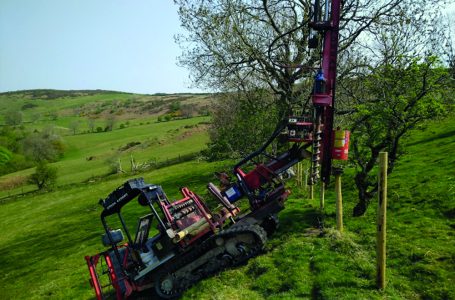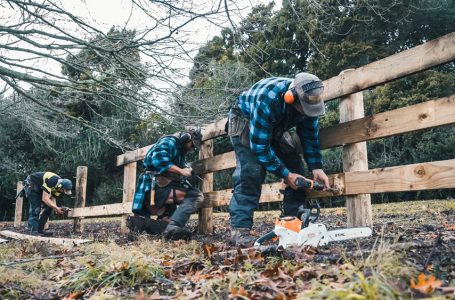CAMPAIGN AIMS TO IMPROVE THE WAY TREATED WOOD IS BOUGHT AND SOLD

Stand at any trade counter and it won’t be long before you hear someone ask for ‘green treated wood’. That’s because many buyers seem to believe that preservative treated wood is a universal product that you can fit and forget in any application, indoors or out.
It’s a perception that many timber merchants, DIY retailers and online traders have helped to perpetuate by promoting construction, fencing and landscaping wood products as either ‘green treated’ or ‘treated against fungal decay’ with no further details about end use suitability or service life.
Producers and sellers have a duty of care to ensure the products they sell are suitable for the application in which they will be used. This obligation is reinforced by consumer and contract law. All too often though it’s the buyer who must navigate the specification ambiguity surrounding preservative treated wood and make the assumption (and take the risk) that what they are buying can be relied on to provide the extended service life required.
A joint market study by The Timber Trades Federation (TTF) and Wood Protection Association (WPA) in 2019 identified that if preservative treated wood was to fully realise its market potential the general failure to specify and buy treated wood correctly must be addressed. The market study also highlighted two other priority objectives: i) the need to improve awareness about how to install treated wood correctly and ii) the need for independent quality verification of the treatment process. These three objectives have been incorporated into a ‘Treatment Action Plan’ by TTF.
Whether a treated wood product has come from a UK producer or is imported, the TTF Treatment Action Plan is intended to serve as a commercial springboard for those who follow best practice and produce treated wood products that are fit for purpose under its ‘Timber You Can Trust’ policy.
The Action Plan was developed in partnership with the WPA which is the principal organisation involved in establishing and guiding the technical and quality standards for industrial wood preservation in the UK. Helping buyers to understand and adopt the specification guidance in BS 8417 – the British Standard Wood Preservation Code of Practice – is the strategy at the core of the joint TTF/WPA communications campaign aimed at improving the way people specify and buy treated wood.
Why unambiguous specification is vital
Preservative impregnation enhances the durability performance (resistance to fungal decay and insects) of wood products and delivers a predictable service life. This is particularly important where wood is to be exposed to the weather or used in direct contact with the ground. However, it’s a big mistake to assume that all preservative impregnated wood is the same. Whilst one piece of treated wood may look very much like any other, the level of preservative protection can be very different. That’s because the wood preservation standard in the UK, BS 8417, requires that the preservative solution strength (loading) and its penetration into a wood product, is tailored specifically to the intended end use of that product. For example, a sawn joist intended for use in a dry internal floor application requires a lower preservative loading and penetration level than a joist used as a structurally important component for a timber deck where it is exposed to the elements and the wet conditions on which wood rotting fungi thrive. Use a joist treated for internal applications out of doors and premature failure, consequential costs and damage to the reputation of wood, the installer and the supplier will be inevitable.
BS 8417 does a good job in simplifying the specification of treated wood. It groups all construction and landscape engineering applications into three basic groups called ‘Use Classes’. Knowing the Use Class for an application determines the minimum amount of preservative that must be impregnated and retained in the wood product to give it the durability to meet the 15 or 30 years desired service life require under this British Standard.
Getting the specification right
It’s absolutely vital that buyers identify the Use Class before buying or ordering treated wood. And its good practice to tell your supplier in writing that the product they supply must be treated in accordance with British Standard BS 8417 for that Use Class. TTF and WPA also urge buyers to ask suppliers to record the treatment Use Class specification on delivery notes and invoices or on a treatment certificate if it is a customer specific volume order or where specialist service treatment provider is involved.
Wherever treated wood is bought from a merchants stock or sourced from an online seller then it is essential that the buyer gets that supplier to verify the Use Class of the product being offered for sale in writing when the only guidance given at point of sale is ambiguous and only extends to describing the wood as ‘treated’, ‘treated for outdoor use’, or ‘green treated’.
A key part of the TTF and WPA campaign is to eliminate any potential for specification misunderstandings by encouraging suppliers to include the application Use Class (confirming the products fitness for purpose) on purchase orders, internal stock movement records, sales records and on all marketing and point of sale information used to promote treated wood products like deck support joists.
The WPA Technical Committee (which includes representatives from BRE and TRADA) is the principal adviser to BSI on the specifications set out in BS8417. Last year it recommended that deck support joists move from Use Class 3u (uncoated) to the higher level of protection required for Use Class 4 ground contact applications. The upgraded specification will bring the standard for decking/outdoor joists in line with USA, Canada, France and Scandinavian countries. It has been adopted by BSI and will appear in the next edition of BS8417.
Some TTF and WPA members have already decided that it is in the best interests of their customers to make the change now by offering deck substructure products meeting the new Use Class 4 specification for both 15 and 30 years desired service life requirements, using either pine or incised spruce. The specification is clearly identified on all associated marketing materials, deliver notes and invoices and is leading the way in improving treated wood buying and selling practices.
Realising the growth potential of treated wood
Bringing about voluntary change in any market is not easy and will take time. The TTF and WPA campaign believe there is the potential for significant growth in demand for high quality, added value preservative treated wood and both trade associations have agreed that they will work together to help ensure treated wood is more accurately and unambiguously specified and purchased. We’ll be featuring more on this campaign in future editions.









